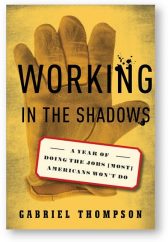July 12, 2011
Written by C.N.
New Books: Immigration at Community & Individual Level
In my last post, I looked at books that examine immigration at the institutional level. To complement that list, below are some recently-released books that highlight the issue of immigration on the community and individual level and provides a more ethnographic and personal account of how political, economic, and legal dynamics operate in the daily lives of immigrants and the neighborhoods in which they live. A book’s inclusion is for informational purposes only and does not necessarily mean a full endorsement of its contents.
Achieving Anew: How New Immigrants Do in American Schools, Jobs, and Neighborhoods, by Michael J. White and Jennifer E. Glick (Russell Sage Foundation)

Can the recent influx of immigrants successfully enter the mainstream of American life, or will many of them fail to thrive and become part of a permanent underclass? Achieving Anew examines immigrant life in school, at work, and in communities and demonstrates that recent immigrants and their children do make substantial progress over time, both within and between generations.
From policymakers to private citizens, our national conversation on immigration has consistently questioned the country’s ability to absorb increasing numbers of foreign nationals–now nearly one million legal entrants per year. Using census data, longitudinal education surveys, and other data, Michael White and Jennifer Glick place their study of new immigrant achievement within a context of recent developments in assimilation theory and policies regulating who gets in and what happens to them upon arrival.
They find that immigrant status itself is not an important predictor of educational achievement. First-generation immigrants arrive in the United States with less education than native-born Americans, but by the second and third generation, the children of immigrants are just as successful in school as native-born students with equivalent social and economic background. As with prior studies, the effects of socioeconomic background and family structure show through strongly. On education attainment, race and ethnicity have a strong impact on achievement initially, but less over time.
Looking at the labor force, White and Glick find no evidence to confirm the often-voiced worry that recent immigrants and their children are falling behind earlier arrivals. On the contrary, immigrants of more recent vintage tend to catch up to the occupational status of natives more quickly than in the past. Family background, educational preparation, and race/ethnicity all play a role in labor market success, just as they do for the native born, but the offspring of immigrants suffer no disadvantage due to their immigrant origins.
Although the picture is mixed and the continuing significance of racial factors remains a concern, Achieving Anew provides compelling reassurance that the recent wave of immigrants is making impressive progress in joining the American mainstream. The process of assimilation is not broken, the advent of a new underclass is not imminent, and the efforts to argue for the restriction of immigration based on these fears are largely mistaken.
Working in the Shadows: A Year of Doing the Jobs (Most) Americans Won’t Do, by Gabriel Thompson (Nation Books)

What is it like to do the back-breaking work of immigrants? To find out, Gabriel Thompson spent a year working alongside Latino immigrants, who initially thought he was either crazy or an undercover immigration agent. He stooped over lettuce fields in Arizona, and worked the graveyard shift at a chicken slaughterhouse in rural Alabama. He dodged taxis—not always successfully—as a bicycle delivery “boy” for an upscale Manhattan restaurant, and was fired from a flower shop by a boss who, he quickly realized, was nuts.
As one coworker explained, “These jobs make you old quick.” Back spasms occasionally keep Thompson in bed, where he suffers recurring nightmares involving iceberg lettuce and chicken carcasses. Combining personal narrative with investigative reporting, Thompson shines a bright light on the underside of the American economy, exposing harsh working conditions, union busting, and lax government enforcement—while telling the stories of workers, undocumented immigrants, and desperate US citizens alike, forced to live with chronic pain in the pursuit of $8 an hour.
Taking Local Control: Immigration Policy Activism in U.S. Cities and States, edited by Monica Varsanyi (Stanford University Press)

With the number of undocumented immigrants in the United States at an all-time high and Congressional immigration reform seemingly at a standstill, cities and states across the nation have leapt into the fray, creating a wide range of policies—some more controversial than others—to address illegal immigration within their jurisdictions. These policies, both anti- and pro-immigrant in nature, run the gamut. Some call for the involvement of city police in immigration enforcement, debates over day laborer markets, the establishment of employer sanctions laws, and the implementation of anti-immigrant ordinances. Other policies call for cities and states to declare themselves “sanctuaries” for undocumented immigrants, passing laws to extend locally-funded health care and social services, offer English language training, and improve wages and working conditions.
While these state and local immigration policies continue to receive wide coverage in the popular press, they have received very little attention in the scholarly literature. This volume aims to fill the gap by offering perspectives from political scientists, legal scholars, sociologists, and geographers at the leading edge of this emerging field. Drawing on high profile case studies, the contributors seek to explain the explosion in state and local immigration policy activism, account for the policies that have been considered and passed, and explore the tensions that have emerged within communities and between different levels of government.
This timely entrant into the study of state and local immigration policy also illuminates the significant challenges and opportunities of comprehensive immigration reform, highlights the range of issues at stake, and charts a future research agenda that will more deeply explore the impacts of these policies on immigrant communities.
Immigrants Raising Citizens: Undocumented Parents and Their Young Children, by Hirokazu Yoshikawa (Russell Sage Foundation)

There are now nearly four million children born in the United States who have undocumented immigrant parents. In the current debates around immigration reform, policymakers often view immigrants as an economic or labor market problem to be solved, but the issue has a very real human dimension. Immigrant parents without legal status are raising their citizen children under stressful work and financial conditions, with the constant threat of discovery and deportation that may narrow social contacts and limit participation in public programs that might benefit their children.
Immigrants Raising Citizens offers a compelling description of the everyday experiences of these parents, their very young children, and the consequences these experiences have on their children’s development. It challenges conventional wisdom about undocumented immigrants, viewing them not as lawbreakers or victims, but as the parents of citizens whose adult productivity will be essential to the nation’s future. The book’s findings are based on data from a three-year study of 380 infants from Dominican, Mexican, Chinese, and African American families, which included in-depth interviews, in-home child assessments, and parent surveys.
The book shows that undocumented parents share three sets of experiences that distinguish them from legal-status parents and may adversely influence their children’s development: avoidance of programs and authorities, isolated social networks, and poor work conditions. Fearing deportation, undocumented parents often avoid accessing valuable resources that could help their children’s development such as access to public programs and agencies providing child care and food subsidies. At the same time, many of these parents are forced to interact with illegal entities such as smugglers or loan sharks out of financial necessity. Undocumented immigrants also tend to have fewer reliable social ties to assist with child care or share information on child-rearing.
Compared to legal-status parents, undocumented parents experience significantly more exploitive work conditions, including long hours, inadequate pay and raises, few job benefits, and limited autonomy in job duties. These conditions can result in ongoing parental stress, economic hardship, and avoidance of center-based child care which is directly correlated with early skill development in children. The result is poorly developed cognitive skills, recognizable in children as young as two years old, which can negatively impact their future school performance and, eventually, their job prospects.
Immigrants Raising Citizens has important implications for immigration policy, labor law enforcement, and the structure of community services for immigrant families. In addition to low income and education levels, undocumented parents experience hardships due to their status that have potentially lifelong consequences for their children. With nothing less than the future contributions of these children at stake, the book presents a rigorous and sobering argument that the price for ignoring this reality may be too high to pay.
Nowhere to Be Home: Narratives From Survivors of Burma’s Military Regime, edited by Maggie Lemere and Zoe West (McSweeney Publishing)

Decades of military oppression in Burma have led to the systematic destruction of thousands of ethnic minority villages, a standing army with one of the world’s highest number of child soldiers, and the displacement of millions of people. Nowhere to Be Home is an eye-opening collection of oral histories exposing the realities of life under military rule. In their own words, men and women from Burma describe their lives in the country that Human Rights Watch has called “the textbook example of a police state.”
Author Citation
Copyright © 2001- by C.N. Le. Some rights reserved. 
Suggested reference: Le, C.N. . "New Books: Immigration at Community & Individual Level" Asian-Nation: The Landscape of Asian America. <https://www.asian-nation.org/headlines/2011/07/new-books-immigration-community-individual-level/> ().
Short URL: https://www.asian-nation.org/headlines/?p=1757
Tags:
Translate Into Another Language![]()
